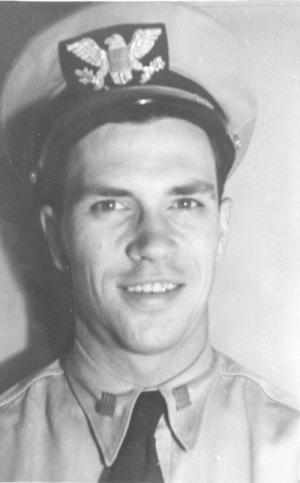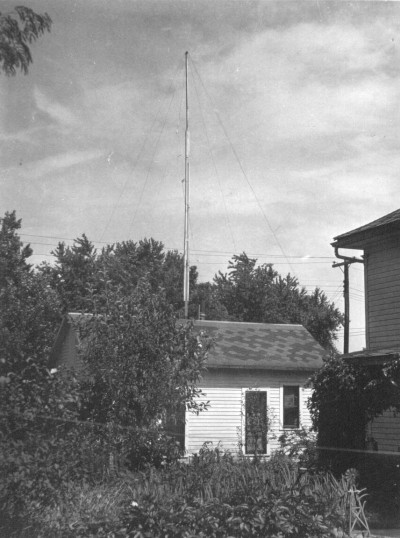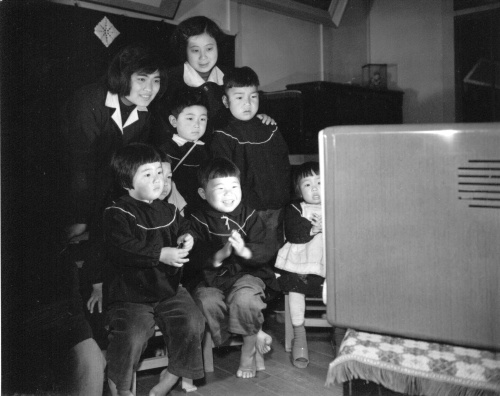By Myra Gold Steinbrink
(Also in January 2003 QST Magazine, page 87)
 |
When 13-year-old Robert Gold was in the 8th grade he designed and built an electric map of the United States. I don't remember exactly how it worked, but there were two wired pointers, and when the state or capital was touched the corresponding state or capital would light up. Everyone marveled at his invention.
In 1932 when Robert was in high school (probably 15 or 16) he built a radio and walnut cabinet to house it for our parents. They had this radio for over 30 years. In 1937 on my 16th birthday (Robert was 21) my brother let my girl friend and me spend that Sunday talking to ham radio operators all over the country. He had recently built his first "rig" which took up one whole little room on the second floor of our house. He later built a combination shop/ham radio building in our back yard. There was always a steady stream of friends who spent a lot of time in that building.
 |
I remember he erected two very tall antennas for that equipment, one on top of the building, the other in a pasture across the street. Electrical storms were always a concern, and I remember when one was struck by lightning. There was also a fire in the radio building. On both occasions Robert got the fires out before the local fire department arrived.
To earn his way through Graceland College (now Graceland University) in Lamoni, Iowa, Robert operated the projectors in the local movie theater. Luckily when he went on to Iowa State College at Ames he was able to do this same type of work the whole time he attended school there. I think it was during the time he was in Graceland I talked him into building a small bedside radio for me, so I could listen to the remote broadcasts of dance bands across the country. There was a price for this; I had to clean his room! All the radio parts he left scattered all over made cleaning a real challenge.
Robert joined RCA in the summer of 1941. I rode with him in his new car to Kansas City, MO, where he was first assigned, but not for long. He was one at the first persons chosen by RCA to be taught the complexities of radar and sonar. A short time later while still working for RCA he was assigned to the US Navy as a Naval Technician, a post he held all during World War II.
After the war Robert was stationed at the New York City office and I remember him telling me when there were only 50 TV sets in the whole city and he was assigned to service them. He knew David Sarnoff (head of RCA) and worked a number of times with Dwight Hemion, winner of 24 Emmy Awards, who directed some of the "specials" that NBC produced. Robert mentioned having been the first to televise the birth of a baby for a hospital or medical school.
 |
In 1957 he traveled to Japan for RCA, to introduce color TV. He said, that at that time the Japanese were having trouble getting color to work properly. He spent quite a bit of time working with the engineers there; some of that long time was because of the language differences. Eventually the Japanese figured it out with his help.
RCA was always sending him to international trade fairs in such places as Greece, Italy, and Germany. Robert and his crew received an Emmy for the process that connects a number of unrelated commercials together. Something we naturally take for granted now.
He was at the Berlin Wall, on May Day just after it was built, broadcasting this event to the world. On the other hand, in 1950 he broadcast the 50th anniversary of the Nobel Prize, and demonstrated the same for the King of Sweden and Sweden's Parliament. Later he was in charge of building the television display for the Museum of Science and Industry in Chicago. He also authored several technical manuals for RCA.
When he traveled to other countries, he made it a point to look up and find fellow hams. He would visit them and see their stations. It is my feeling that during the 40+ years spent working for RCA; he never really lost his love of being a "ham" radio operator.
I remember the last time I saw my brother at lunch in Philadelphia in 1988 or 1989 he showed me a "circuit board" he had sketched out and wanted me to draft it up for him. By that time he was suffering from Parkinson's disease. That board never came to pass, however, but his mind was still figuring out electrical puzzles.